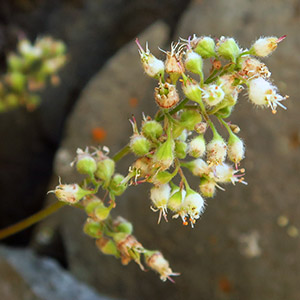Heuchera merriamii
Heuchera pulchella
Canyon Creek alumroot, Merriam's alumroot
sandia mountain alumroot
11–32 cm, long stipitate-glandular or glabrate.
7–15 cm, short stipitate-glandular.
petiole (2.4–5 cm), moderately long stipitate-glandular;
blade orbiculate, reniform, or pentagonal, shallowly 5–7-lobed, 2.5–4.5 cm, base shallowly cordate to truncate, lobes rounded, margins dentate, apex rounded to obtuse, surfaces finely long stipitate-glandular abaxially, sparsely long stipitate-glandular adaxially.
petiole short or long stipitate-glandular;
blade orbiculate, deeply 5-lobed, 0.5–2 cm, base cordate, lobes rounded, margins dentate, apex obtuse, surfaces short stipitate-glandular and sparsely long stipitate-glandular on veins abaxially, short stipitate-glandular adaxially.
dense; (bracts linear and scarious to 3–5-parted and herbaceous).
dense, (secund).
hypanthium radially symmetric, free 0.5–1.5 mm, pink, hemispheric, 3–5.5 mm, (base rounded), densely long stipitate-glandular;
sepals erect, green- or red-tipped, equal, 1–2 mm (often wider than long), apex obtuse;
petals erect, white, oblanceolate, (clawed), unlobed, 2–3.5 mm, margins entire;
stamens exserted 0.8–2 mm;
styles exserted 1–2 mm, 1.5–2.5 mm, 0.1+ mm diam.
hypanthium moderately bilaterally symmetric, free 1–1.5 mm, reddish or dark rose, campanulate, 4–5.5 mm, short stipitate-glandular proximally, long stipitate-glandular distally;
sepals somewhat spreading, darker red on tips, equal, 0.8–1.8 mm, apex obtuse or rounded;
petals spreading, pink, lanceolate, (clawed), unlobed, 2–2.5 mm (longer than sepals), margins entire;
stamens exserted 1 mm;
styles exserted 1–1.8 mm, 1.5–2 mm, 0.1+ mm diam.
ovoid, 3–5 mm, beaks divergent, not papillose.
ovoid, 5 mm, beaks divergent, not papillose.
dark brown, ellipsoid, 0.6 mm.
dark brown, ellipsoid, 0.8 mm.
= 14.
Heuchera merriamii
Heuchera pulchella
Heuchera merriamii is known from the Siskiyou and Trinity mountains.
(Discussion copyrighted by Flora of North America; reprinted with permission.)
Of conservation concern.
Heuchera pulchella occurs in northern and central New Mexico. It resembles H. abramsii, H. brevistaminea, H. caespitosa, and H. elegans; it is isolated geographically from the other species of this complex, all of southern California.
(Discussion copyrighted by Flora of North America; reprinted with permission.)


